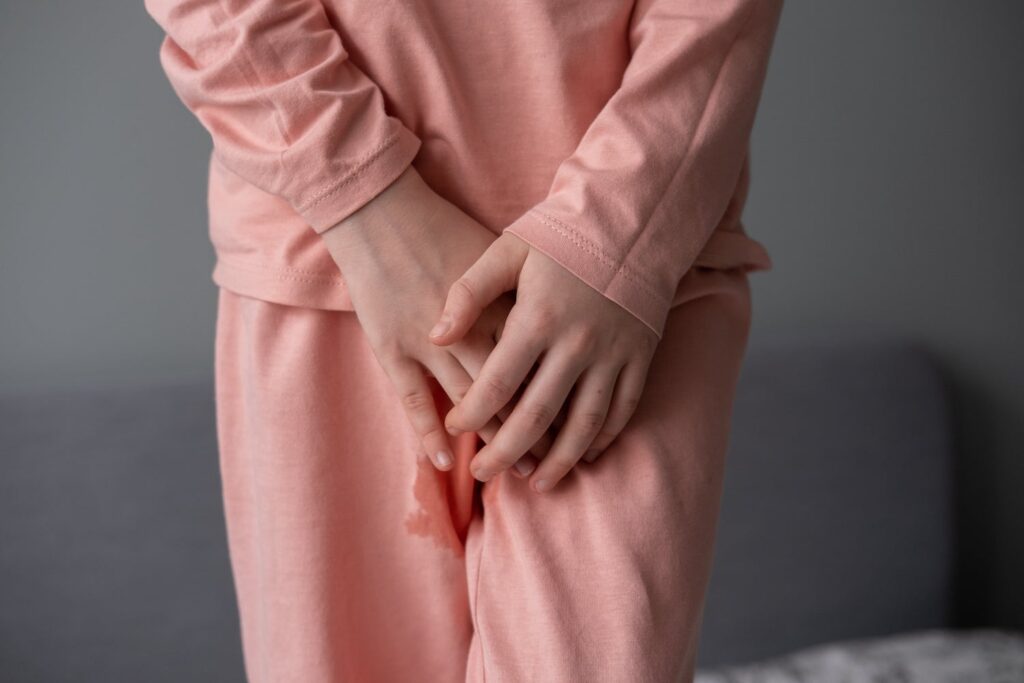Urinary incontinence is a medical condition that describes the loss of bladder control. This can cause accidental urine leakage and occurs more commonly in older people, especially among women. In Singapore, the condition affects about 4.6% to 14.5% of Singaporeans, but because of the embarrassment surrounding the issue, cases are severely underreported.
Urinary incontinence can occur due to a number of reasons, such as weak pelvic floor muscles, overactive bladder muscles and nerve damage. Although often seen as a part of ageing, there are a variety of treatments that can effectively treat and/or manage urinary incontinence symptoms.

There are several types of urinary incontinence, such as:
Stress incontinence occurs when the urethral sphincter, the pelvic floor muscles, or both have been damaged or weakened, resulting in the inability to hold in urine especially when the pressure inside the bladder is increased. Studies have also shown that women who give birth vaginally are more likely to develop stress incontinence as a result of pelvic floor muscles being stretched and weakened.
Symptoms include urine leakage when pressure is put on the bladder, such as jumping, laughing, coughing or sneezing.
The most common cause of urge urinary incontinence is due to an overactive bladder. Overactive bladder syndrome occurs when someone feels a strong urge to urinate even though his or her bladder is not full. This usually occurs due to involuntary contractions of the bladder muscles even though the bladder is not completely full. Damage to the brain, nerves or spine can result in an overactive bladder.
One symptom of an overactive bladder is an overwhelming urge to urinate.
Mixed incontinence is when someone has both urge and stress urinary incontinence. Mixed incontinence can also occur in men who have had prostate surgery.
Overflow incontinence usually occurs when there is an obstruction preventing the normal flow of urine from the bladder. Over time, this results in the bladder becoming overfilled and hence, leakage of urine.
Overflow incontinence is usually more common in men as a result of prostate-related conditions. Nerve damage and ageing can also lead to overflow incontinence because of the bladder muscles’ inability to contract properly.
Symptoms of overflow incontinence include urine leakage due to a bladder that does not empty completely.
Functional incontinence occurs when the urinary tract is functioning properly, but other illnesses or disabilities are preventing you from urinating properly. This typically occurs when someone has a disability that prevents them from getting to a washroom in time.
Nocturia refers to a condition where you wake up more than once each night to urinate. There are various causes of nocturia.
You should consult a doctor if you are experiencing any symptoms of urinary incontinence, such as leakage of urine. Many of these conditions can be managed effectively with minimally invasive methods.
During your first visit with the urologist, they will take a comprehensive recount of your symptoms and medical history.
Urinary incontinence can be diagnosed in a number of ways, including:
Your doctor may ask you to keep a diary of your bladder habits for a few days to get a better understanding of the nature of your urinary incontinence. This can include how much fluid you drink, the types of fluid you drink, how often you would need to pass urine, the amount of urine you pass, as well as how many episodes of incontinence you have experienced.
Your urologist may perform a physical examination to help them in assessing your urinary health.
In order to rule out lower urinary tract symptoms caused by urinary tract infection or stones or cancers, your urologist may order a urinalysis to screen for such conditions.
A series of blood tests can be carried out to assess kidney function (renal panel) and even a PSA (prostate-specific antigen) test for prostate cancer in men.
A residual urine test may be done if your doctor suspects that you may have urinary flow obstruction or overflow incontinence. An ultrasound scan of the bladder is being done to see how much urine is left behind in the bladder after you pass urine.
Real-time video urodynamics combines the functional test of the lower urinary tract with real-time fluoroscopy to examine the structure and function of the urinary tract. This allows for the detection of structural and functional abnormalities such as incompetent bladder neck or sphincter deficiency. It also allows the doctor to discern the pressure, capacity and flow of the bladder during the filling and emptying of the bladder.
An ultrasound of the kidneys may be performed to detect any swelling of the kidneys as a result of an over-distended bladder. An ultrasound bladder can be done to detect any structural abnormalities in the bladder, including stones or growths. An ultrasound prostate can also be done for men to check for enlargement of the prostate.
This test involves the insertion of a cystoscope through the urethra to inspect the urethra, prostate and bladder.
Depending on the severity of urinary incontinence, there are a variety of treatment options, from minimally invasive methods to surgical intervention.
Treatment largely depends on the type of urinary incontinence you have and the symptoms you experience. Urinary incontinence can be cured if the underlying condition causing the symptoms can be reversed. Other forms of treatment involve long-term management.
In summary, urinary incontinence can affect one’s quality of life, causing distress and embarrassment to the patient. However, there are also a variety of treatments to effectively treat or manage urinary incontinence symptoms. It is important to communicate both your needs and desired outcomes with your urologist so that they may work with you on creating a treatment plan that best suits you.

MBBS, MRCSed, MMED(Surgery)
Dr Terence Lim is a Senior Consultant Urologist with a subspecialty in Uro-Oncology. He is also the Medical Director at Assure Urology & Robotic Centre. His clinical interests include Uro-Oncology, Minimally-invasive Urological Surgery, Urinary Stone Disease, Endourology and Prostate Health.
Prior to his private practice, Dr Terence Lim spent almost two decades in public healthcare. He served as the Senior Consultant and Chief of the Department of Urology at Changi General Hospital (CGH). In addition, he is currently a Visiting Consultant at CGH. Dr Lim was also the director of CGH’s Advanced Surgical Centre, a committee dealing with complex surgeries, including robotic surgeries.
Your health is important to us and some conditions require immediate attention. For emergencies, please contact us at 9835 0668.

MBBS, MRCSed, MMED(Surgery)
Dr Terence Lim is a Senior Consultant Urologist with a subspecialty in Uro-Oncology. He is also the Medical Director at Assure Urology & Robotic Centre. His clinical interests include Uro-Oncology, Minimally-invasive Urological Surgery, Urinary Stone Disease, Endourology and Prostate Health.
Prior to his private practice, Dr Terence Lim spent almost two decades in public healthcare. He served as the Senior Consultant and Chief of the Department of Urology at Changi General Hospital (CGH). In addition, he is currently a Visiting Consultant at CGH. Dr Lim was also the director of CGH’s Advanced Surgical Centre, a committee dealing with complex surgeries, including robotic surgeries.
Your health is important to us and some conditions require immediate attention. For emergencies, please contact us at 9835 0668.
No issue is too small. Contact any of our friendly staff and we will get back to you as soon as possible.
Reach out to us for expert urological care.
For enquiries, leave a message and our friendly team will get in touch with you.
For urgent enquiries after office hours, call or WhatsApp us at (65) 9835 0668.
Monday – Friday: 9:00AM – 5:00PM
Saturday: 9:00AM – 12:30PM
Sunday & Public Holiday: CLOSED

© 2023 All Rights Reserved | Assure Urology & Robotic Centre | Terms & Conditions